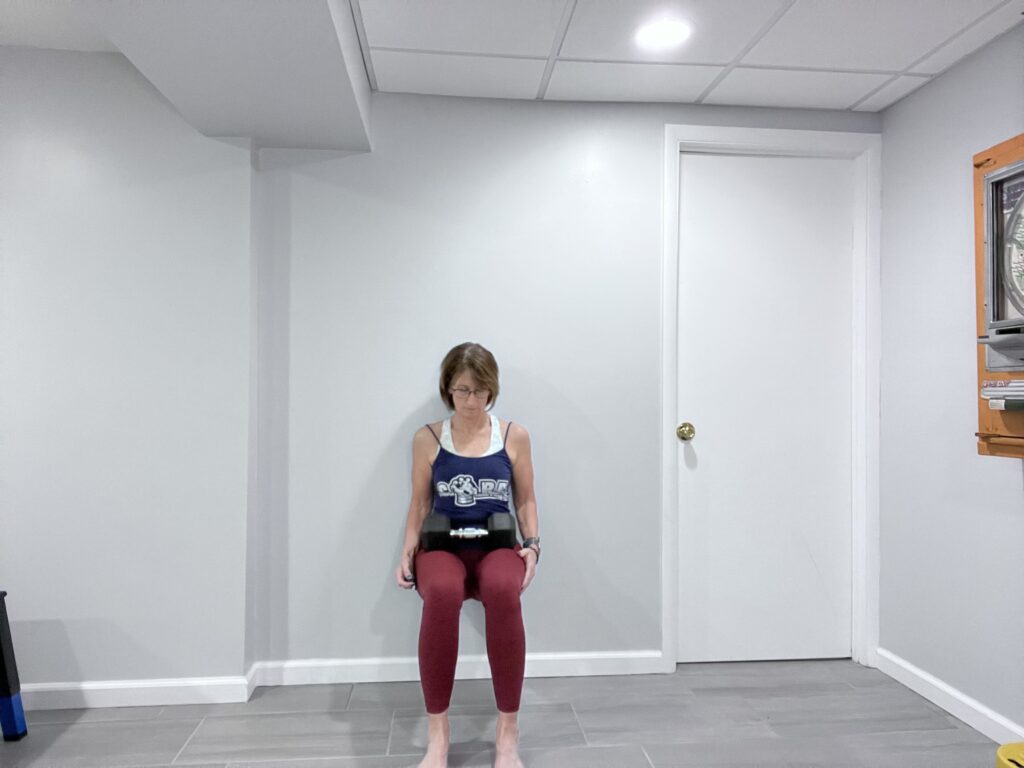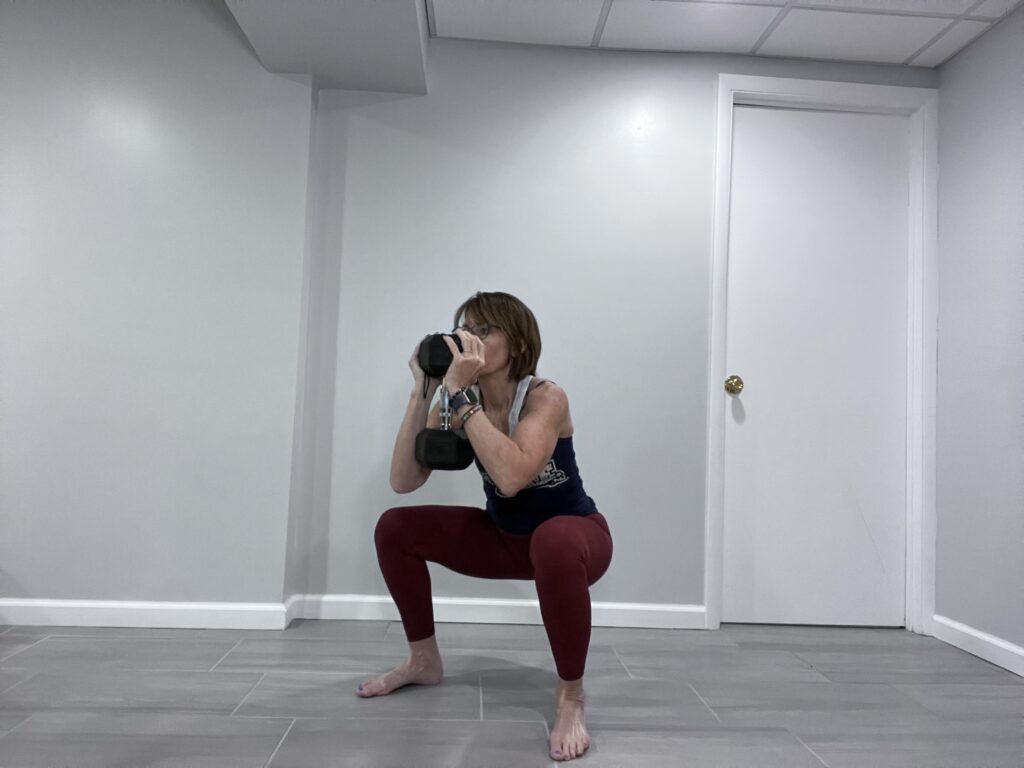7 Easy Squats for Aging Knees: Tips and Techniques
Do you have aging knees but want to find a way to safely continue weight bearing exercises like squatting?
As someone who has struggled with knee pain as I’ve aged, I know how difficult it can be to maintain a fitness routine.
Squats, in particular, can be a challenge for those of us with bad knees. But don’t let your sore joints stand in the way of staying in shape.
I am a big fan of squats and certainly don’t want to stop doing them during my workouts because of my knees!
So, I have found that with a few modifications and alternate techniques, we can still reach our fitness goals while protecting ourselves from further pain or injury.
So, if you’re determined to stay active and improve your chronic knee pain issues without killing yourself in the process, keep reading for all my recommended hacks on how to perform squats for aging knees at home!
This post may contain affiliate links. As an Amazon Associate, I earn from qualifying purchases. This means I may earn a commission at no extra cost to you should you choose to make a purchase using my link.
The Importance of Proper Form
Proper form is crucial when performing squats.
Not only does it help prevent further injury, but it can also improve your overall strength and mobility.
Squatting Mechanics
Proper squatting mechanics involve using the correct muscles and joints to perform the movement.
When squatting, it is important to engage your glutes, quadriceps, and hamstrings while keeping your knees and hips in alignment.
This can help distribute your weight evenly and reduce the strain on your knees.
Posture and Alignment
Posture and alignment are also important factors to consider when performing squats.
It’s important to keep your spine in a neutral position and your shoulders back and down. This can help prevent unnecessary strain on your back and neck.
To maintain proper posture and alignment, try the following tips:
- Keep your feet shoulder-width apart.
- Keep your toes pointed slightly outward.
- Engage your core muscles.
- Keep your eyes forward.
- Lower your body slowly and with control.
By following these tips and focusing on proper form, you can perform squats safely and effectively, even with bad knees.
Safe Squats for Bad Knees
When it comes to squatting with bad knees, safety should always come first.
Here are some safe squatting techniques that I have found helpful:
Wall Squats for Bad Knees
Wall squats are an excellent way to build strength in your legs while avoiding the pressure on your knees.
Here’s how to do it:
- Stand with your back against a wall.
- Place your feet shoulder-width apart and about a foot away from the wall.
- Slowly lower yourself down into a squatting position, keeping your back against the wall.
- Hold for a few seconds, then slowly rise back up.
- Increase your time in the squat as you are able to tolerate it.
- As you progress you can add a weight on your quads as you hold your squat.

Chair Squats for Bad Knees
Chair squats are another great option for those of us with bad knees.
Here’s how to do it:
- Stand in front of a chair facing away from the chair.
- Place your feet shoulder-width apart.
- Slowly lower yourself down into a sitting position on the chair – try to avoid using your hands.
- Hold for a few seconds, then slowly rise back up without using your hands.
Goblet Squats for Aging Knees
Goblet squats are a great way to work on your form and build strength in your legs.
Here’s how to do it:
- Hold a weight or a heavy object (like a kettlebell) close to your chest.
- Stand with your feet shoulder-width apart.
- Slowly lower yourself down into a squatting position, keeping your back straight and your weight on your heels.
- Hold for a few seconds, then slowly rise back up.

Box Squats
Box squats are a great way to build strength in your legs while also reducing the pressure on your knees.
Here’s how to do it:
- Stand in front of a box or a bench – facing away from the box or bench.
- Place your feet shoulder-width apart.
- Slowly lower yourself down onto the box or bench, keeping your back straight and your weight on your heels.
- Hold for a few seconds, then slowly rise back up.
Remember, it’s important to listen to your body and not push yourself too hard.
Start with a few reps and work your way up slowly.
With these safe squatting techniques, you can build strength in your legs without putting unnecessary pressure on your knees.
Equipment and Easy Modification for Squats
Wall Squats with Stability Ball
When it comes to squats for aging knees, stability ball squats are a great option.
Using a stability ball can help reduce the impact on your knees and provide extra support for your lower back.
To perform stability ball wall squats:
- Start by placing a stability ball between the wall and your lower back while facing away from the wall.
- Walk your feet out slowly.
- Lower your body towards the floor in a squat position as while pushing your low back into the ball.
- You can hold this position for 30-60 seconds or for a shorter period and do reps instead.
- Then straighten your legs, while keeping your weight on your heels.
- Return to standing position.
- Make sure to keep your core engaged and your knees aligned with your toes throughout the exercise.
Dumbbell Squats
Adding weights to your squats can help strengthen your legs and improve your overall fitness.
Dumbbell squats are a great option for those with bad knees because they allow you to control the amount of weight you use and the range of motion.
To perform dumbbell squats:
- Hold a dumbbell in each hand with your arms at your sides.
- Stand with your feet shoulder-width apart and slowly lower yourself into a squat, keeping your back straight and your knees aligned with your toes.
- Push back up to the starting position and repeat.
Resistance Band Squats
Resistance bands are a great tool for adding resistance to your squats without putting too much stress on your knees.
To perform resistance band squats:
- Step on the band with both feet,
- Holding the ends of the band at shoulder height.
- Slowly lower yourself into a squat, keeping your back straight and your knees aligned with your toes.
- Push back up to the starting position and repeat.
You can adjust the resistance of the band by changing the length or thickness of the band.
Modifications and equipment can make squats for aging knees safer and more effective.
By using a stability ball, dumbbells, or resistance bands, you can reduce the impact on your knees and improve your overall fitness.
Remember to always consult with a doctor or physical therapist before starting any new exercise routine.
Muscles Involved in Squats
Squats are a compound exercise – which means that they work more than one muscle group to complete the exercise.
By doing compound exercise, you will strengthen several muscles in your lower body and core.
When done correctly, squats can help improve your overall fitness, increase your muscle mass, and reduce your risk of injury.
Here are the muscles involved in squats:
Quadriceps
The quadriceps, also known as the quads, are the muscles located in the front of your thighs.
They are the primary muscles used during squats and are responsible for extending your knees.
Glutes
The glutes, or gluteal muscles, are the muscles located in your buttocks.
They are the secondary muscles used during squats and are responsible for extending your hips.
Hamstrings
The hamstrings are the muscles located in the back of your thighs.
They are the tertiary muscles – which means that they are not the primary or secondary muscles. You don’t even think about them until they are injured.
They are used during squats and are very important since they are responsible for flexing your knees and extending your hips.
Lower Back
Your lower back muscles are also activated during squats, especially during the lowering phase.
They are responsible for stabilizing your spine and preventing injury.
Abdominal Muscles
Your abdominal muscles are activated during squats to help stabilize your core and maintain balance.
Squats are an excellent exercise for strengthening your lower body and core.
By targeting multiple muscle groups, squats can help improve your overall fitness and reduce your risk of injury.
Preventing Injuries
As someone with bad knees, I know how important it is to prevent injuries while doing squats at home.
Here are some tips to keep in mind:
- Warm-up: Before starting any exercise, it’s very important to warm up your body. A few minutes of light cardio, such as walking or cycling, can help increase blood flow to your muscles and prepare your body for the workout.
- Use proper form: Using proper form while doing squats is most important to prevent injuries. Make sure your knees are in line with your toes, and your back is straight. If you’re not sure about your form, you may want to consider hiring a personal trainer or watching instructional videos.
- Start with bodyweight squats: If you’re new to squats or have bad knees, start with bodyweight squats. This will help you build strength and endurance without putting too much pressure on your knees.
- Listen to your body: If you experience any pain or discomfort while doing squats, stop immediately. Pushing through the pain can lead to further injuries.
- Include other exercises: To prevent injuries, it’s important to strengthen the muscles around your knees. Consider adding other exercises, like lunges, deadlifts, and calf raises, into your workout routine.
By following these tips, you can prevent injuries and safely do squats at home.
Remember to take it slow and listen to your body.
If you experience any pain or discomfort, consult with a medical professional.
Conclusion
Aging knees can be a challenge, but with proper technique, anyone can still do squats.
Keeping your feet shoulder-width apart and having a slight forward chest tilt will help you perform squats with ease while protecting your knees from injury.
When starting off, keep the repetitions low and always warm up beforehand to avoid straining yourself.
As you progress in your practice, begin elevating your heels or using a weighted barbell for an extra challenge.
Remember to take it easy, listen to your body’s signals, and never push too far outside of your comfort zone.
Ultimately, learning more about how different muscles engage during squats can help you protect and strengthen those aging joints!
So, what are your favorite squats? Let me know below!
